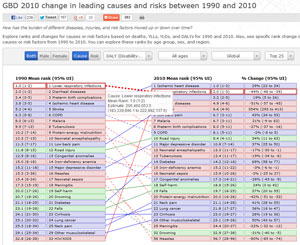Global disease study reveals successes, challenges
January / February 2013 | Volume 12, Issue 1

Dr. Christopher Murray, Director of the Institute of Health
Metrics and Evaluation (IHME) at the University of
Washington spoke recently at NIH on The Global Burden
of Disease Study 2010.
A landmark study of the global causes of death and disability shows a dramatic shift from infectious to noncommunicable diseases - with the exception of sub-Saharan Africa, where the scourges of HIV/AIDS and malaria remain entrenched. The
Global Burden of Disease Study 2010 , published as a special edition of
The Lancet, is the largest ever systematic effort to describe the worldwide distribution and causes of a wide array of diseases, injuries and health risk factors. Nearly 500 scientists from 50 countries participated, with more than half located in low- and middle-income countries.
While child mortality used to be the largest contributor to the world's health burden, injuries and chronic diseases now pose the biggest challenges and are multiplying as people live longer. Since 1970, men and women worldwide have gained slightly more than 10 years of life expectancy, the study reported, but they spend more years living with injury and illness.
"We're finding that very few people are walking around with perfect health and that, as people age, they accumulate health conditions," noted Dr. Christopher Murray, director of the
Institute of Health Metrics and Evaluation at the University of Washington, and one of the founders of the Global Burden of Disease project. "At an individual level, this means we should recalibrate what life will be like for us in our 70s and 80s. It also has profound implications for health systems as they set priorities."
Global Burden of Disease Study 2010:
Change in disability-adjusted life years,
by cause, rank
Access
GBD 2010 data visualizations , such as disability-
adjusted life years, by cause and rank, shown below, to
explore the ranks and changes for causes or risk factors
by age group, sex and region.

The types of illnesses and injuries causing death and disability are also changing. While ischemic heart disease and stroke remained the two greatest causes of death between 1990 and 2010, all the other rankings in the top 10 changed. Diseases such as diabetes, lung cancer and chronic obstructive pulmonary disease moved up, and diarrhea, lower respiratory infections and tuberculosis moved down. Notably, measles plunged from 12th to 38th place, thanks to improved vaccination programs. HIV/AIDS, not even in the top 20 in 1990, surged to number six.
GBD 2010 is the only comprehensive picture of human illness and death worldwide, noted Sir Richard Feachem, Director of the Global Health Group at the University of California, San Francisco. "It will be of immense value to policymakers and public health practitioners in all countries. It will also generate heated debate, which will lead to further advances in data collection and analysis and better estimates in the future."
The study is an "indispensable resource," observed Dr. Jim Kim, president of the World Bank Group. "Its value lies not only in the data but the critical discussions it makes possible. Specifically, the GBD 2010 has sharpened thinking on issues as diverse as the measurement of comorbidities; the role of culture in mediating the experience of disease; the meaning of disability; and the impact of poverty on health."

Photo by Caroline Penn/
Wellcome Trust
Murray outlined significant aspects
of the global health burden, including
the improved condition of children
A few weeks after the report's launch, Murray presented the data to an NIH audience and spent a day on campus leading small group discussions on various aspects of the study. In his talk, Murray outlined four significant aspects of the global health burden, including the improved condition of children, shift to noncommunicable diseases, large impact of disability and dominant health risks around the world.
Along with the good news of a declining trend in infectious diseases and other life-shortening conditions related to birth and nutrition, comes the bad news of a rising burden from noncommunicable disease, Murray noted. Death is increasingly caused by cardiovascular conditions, cancers or diabetes, rather than malaria, pneumonia or diarrhea. "The pace of the cause of death transition is quite fast," he said.
Sub-Saharan Africa is also showing a rising proportion of burden from noncommunicable diseases, although this change is occurring more slowly than in the rest of the world. Because of HIV/AIDS, the burden of infectious diseases is actually rising in a handful of countries, Murray noted.
Leading causes of disability differ from those bringing early death. Lower back pain tops the list nearly everywhere, followed closely by depression. Other common problems are anemia, muscular-skeletal disorders, migraines, vision or hearing loss, injury and endocrine diseases.
The last two decades have seen a change in risk factors behind health burdens, Murray noted. Today, the largest factor is elevated blood pressure, followed by tobacco, alcohol and household air pollution. Collectively, diet accounts for about 10 percent of the burden of disease risk and obesity is the sixth most common risk factor, he said.

The NIH Director Dr. Francis S. Collins (left) and Fogarty
Director Dr. Roger I. Glass (right) joined Dr. Christopher
Murray of IHME (center) as he presented on and
discussed data from GBD 2010 data at NIH.
Murray urged the NIH to collaborate on future disease burden studies and suggested the project could transition to a continuously updated open access dataset that would reflect the latest available information. He also noted the team plans to improve research methods, produce forecasts, obtain extensive feedback on drug and vaccine adverse effects, and track dollar costs by disease and injury categories.
Common standards, transparent peer review and better data are also needed, suggested WHO Director General, Dr. Margaret Chan. "We must not forget that the real need is to close the data gaps, especially in low-income and middle-income countries, so that we no longer have to rely heavily on statistical modeling for data on disease burden. Accountability for health should be based on sound monitoring of results, tracking of resources and transparent reviews, with a focus on equity."
More Information
To view Adobe PDF files,
download current, free accessible plug-ins from Adobe's website .